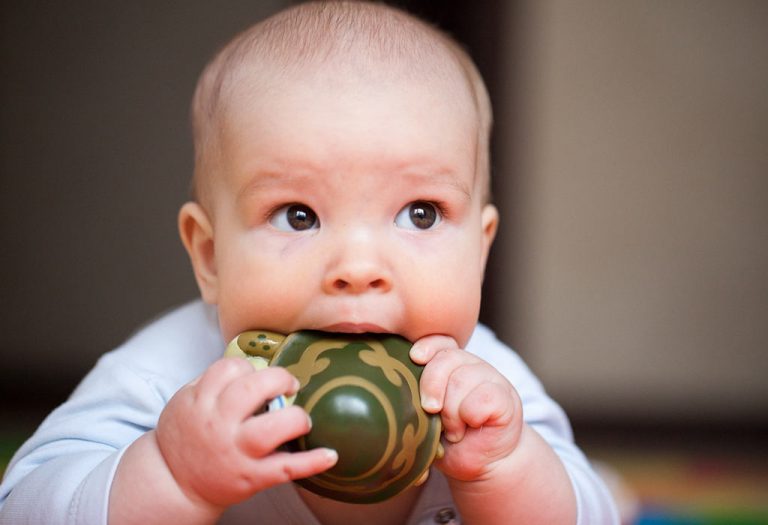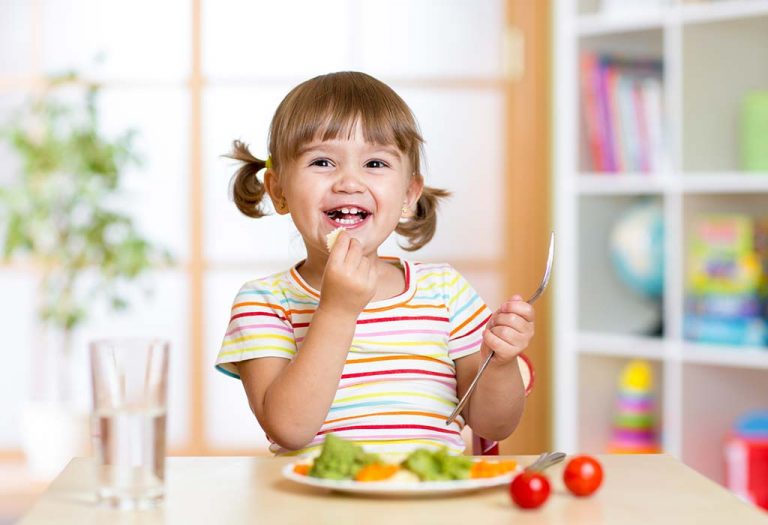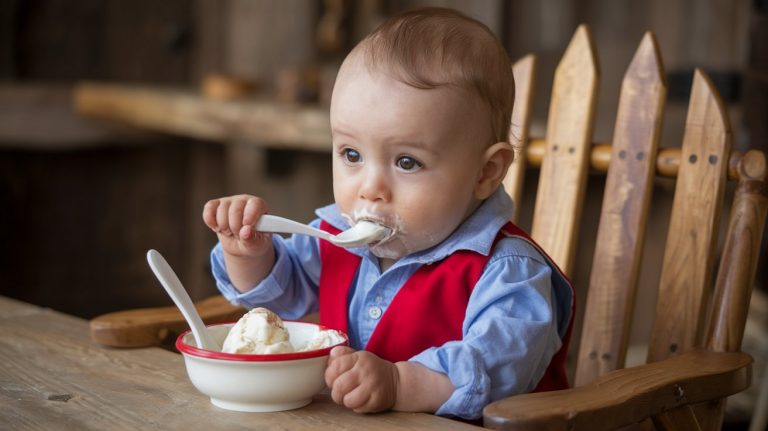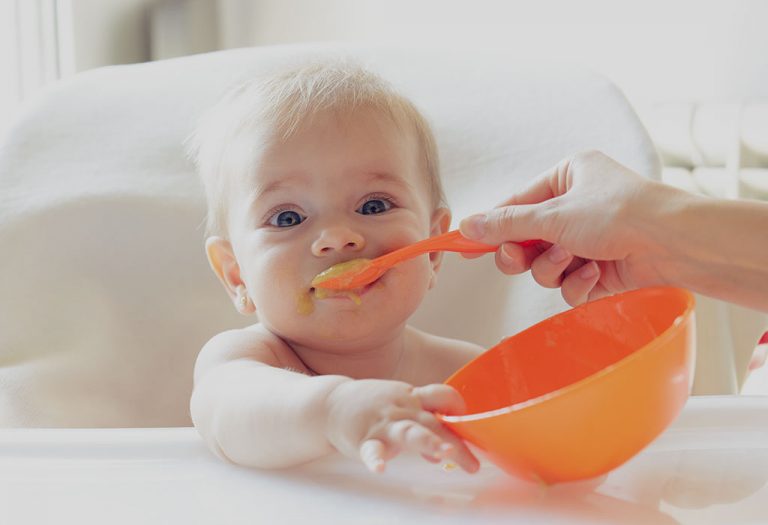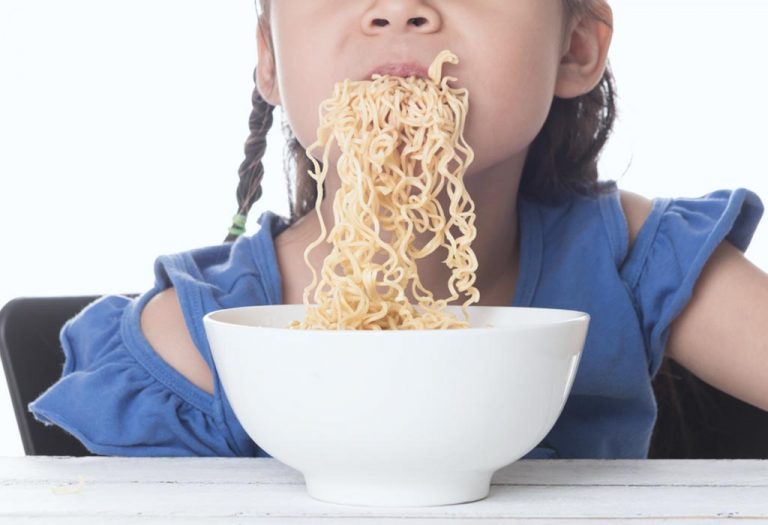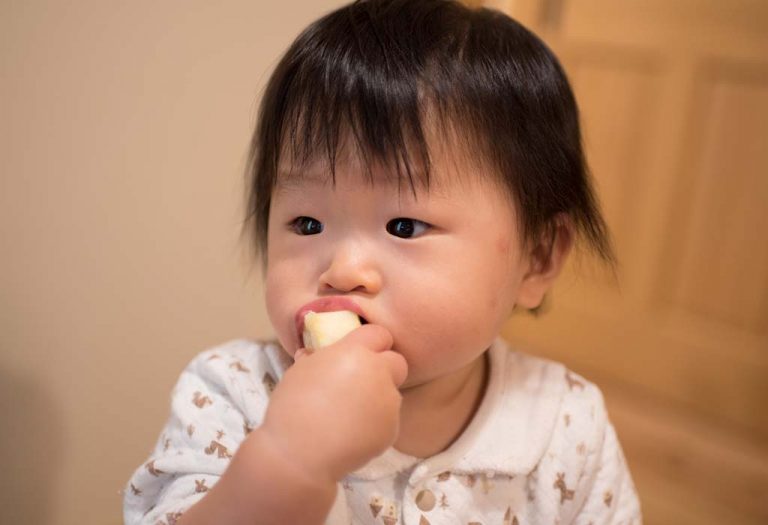How to Teach a Baby to Chew Food – A Guide for Parents

If you’re a parent to a toddler, one of the biggest challenges that you face must be getting your independent toddler to chew food. An act that seems natural to us might not be the same for the little ones who are just getting used to the concept of eating solid food items. There will be days when you might lose your patience while trying to feed your child and force him to chew food. But you know well that using force (or exhibiting anger) is not the ideal solution to get children to listen to you. Here’s how to teach a baby to chew.
What Is Chewing?
In simple terms, the act of breaking down food in the mouth by crushing and grinding it, as a way to stimulate the digestive process, is termed chewing.
When Can a Baby Start Chewing Food?
When do babies start chewing? Babies start experimenting with their mouths by using their fingers and other toys. The act of chewing mainly begins when they are close to completing a year. This is precisely why most parents are advised to introduce new food items in this phase, to encourage that chewing activity. The coordination of the tongue, jaws, and swallowing is the core part of the act of chewing food properly.
Factors to Consider When Teaching Your Baby to Chew
Teaching a baby to chew is an important developmental milestone that lays the foundation for healthy eating habits. It requires patience, attention, and consideration of the following factors to ensure the process is safe and effective.
1. Age
According to the Cleveland Clinic, babies typically begin to swallow solid foods around six months old (1). Therefore, the development of chewing skills coincides with the ability to consume solids.
2. Extrusion Reflex
An innate mechanism called the extrusion reflex prompts babies to push out any solid food placed on their tongues, minimizing the risk of choking. As per NHMRC’s Infant Feeding Guidelines, this reflex typically diminishes by the age of six months (2), marking an initial step towards chewing proficiency.
3. Gag Reflex
Similar to the extrusion reflex, the gag reflex serves as a protective mechanism against choking by prompting babies to expel solid food placed near the back of their tongues. According to the Royal Children’s Hospital Melbourne, this reflex diminishes after approximately six months (3), facilitating the progression towards chewing abilities.
4. Practice
Chewing can commence even before the appearance of teeth. Introducing soft and pureed baby foods after six months provides opportunities for babies to practice chewing motions. Gradually varying the texture of foods offered allows babies to develop their chewing skills, utilizing different parts of the mouth.
5. Teething
Teething plays a crucial role in the development of chewing as teeth enable babies to break down firm foods into smaller, manageable pieces. By the time babies start teething, they have already gained some familiarity with basic chewing motions, facilitating their transition to more solid foods.
Can Babies Chew Food Without Teeth?
Most of the chewing activity is conducted by the molar teeth in the jaw. While your little one might not have molars until he is around 1.5 years or so, the gums are healthy enough for light chewing activities. The chewing movement and technique are all that’s left to learn.
Why Does Your Baby Refuse to Chew?
Is your baby not chewing food? All infants are equipped with a reflex known as the “tongue thrust,” aiding in the movement of the tongue during breastfeeding or bottle feeding. This reflex also assists in pushing objects, such as food, forward and out of their mouths as a safety measure against choking.
Around the ages of 4 to 7 months, the tongue-thrust reflex begins to integrate, coinciding with the introduction of solid foods. Initially, you may observe that your baby frequently spits out food, indicating that they may not have chewed it adequately or that it’s too large to swallow. However, with consistent practice, most babies enhance their abilities and develop new techniques for manipulating food in their mouths.
If your baby shows reluctance to consume any solids (whether purees or soft finger foods) by 9 months of age, or if they solely consume purees by 12 months, it’s advisable to consult your pediatrician for potential referrals to healthcare professionals who can provide assistance.
Why Is Chewing Food a Problem for Some Toddlers?
No child can start chewing food right away. Every child has his own learning curve and most kids start chewing food when they reach the toddler stage. At times, a few kids can pose numerous problems around it, which are primarily due to a few significant reasons.
1. Lack of Interest in Food
Some children might be exposed to a meal plan that has similar food items repeating quite often. At times, they also have an affinity for easy-to-chew foods making them lose their interest in attempting to try foods with different tastes and textures.
2. An Absence of Lumpy Foods in Early Stages
By the time a child turns nearly a year old, it is recommended that different tastes and textures of foods be introduced to him. For a child purely dependent on breast milk by this age, chewing can be quite a difficult task to handle later in life.
3. Delayed Introduction to Solid Foods
Chewing is a skill that needs development pretty early in life. If you choose to introduce solids only after he has grown up, your child may experience difficulty in accepting such food items and would prefer to drink milk all the time.
Tips to Teach a Baby to Chew Food
Your child may have some difficulty chewing his food as he begins to learn it initially and it is normal. With a few tips, you can make that more comfortable for him as well as peaceful for you, too.
1. Keep Yourself Calm
Before you even attempt to start teaching your little one how to chew, there needs to exist an atmosphere of peace and calm. If your little one is upset and is not in the mood, it’s not going to be easy for you to get him to chew food, and as a result, you might lose your patience. Your own stress can counteract the appetite of the child and prevent him from any attempts at chewing his food. So you must ensure that you don’t lose your calm while trying to get your child to eat and chew food. Make mealtimes a fun activity.
2. Pick Appropriate Food Items
While it is essential that you introduce a variety of foods to your child to help him meet nutritional requirements, you must note that he should be able to chew whatever you feed him. Giving him grapes or popcorn might not be a great choice if he can’t chew them well. The risk of food being lodged in his throat and causing him to choke is quite real.
3. Feed Him When He’s Hungry
Children find chewing to be a needless activity and would do everything they can to avoid it. A child with his stomach full will barely even touch any food item that requires chewing. Therefore, turn the tables by offering those items when your child’s hunger is at its peak. He might resist initially but the hunger will soon take over and leave him no choice but to eat the food by chewing it well.
4. Let Him Eat On His Own
Children who refuse to chew are usually self-driven and want to do things their way. You can use this quality to your advantage as well. Set up his mealtime with the foods in a bowl and give him a small spoon. He will do everything he can to use the spoon properly, even if it involves eating foods that require him to chew them properly. Don’t fret if he manages only a few bites. That’s a pretty good start on its own.
5. Opt for a Fruit Feeder
Fruits are quite essential for toddlers but it’s difficult for most toddlers to chew them. Some children tend to slurp on them to get the flavour and leave the fruit as is while others may refuse to eat the fruit. If your toddler, refuses to eat the fruit, you should get a fruit feeder. These are mesh bags that hold the fruit pieces together. Since they are FDA-approved, kids can use them to lick and feel the fruit, as well as bite them comfortably.
6. Prepare Small Food Items That Are Soft
As your little one grows, he will reach a stage, where he will be able to eat and chew food of different tastes and textures. But while he is young, you need to be easy on him and take it slow (4). You can make healthy and tasty finger foods for him that he can easily chew on. Prepare something that is easy to chew on and melts in the mouth soon enough.
7. Allow Your Child to Use a Grabber Toy
Apart from chewing on foods, children also take their time in understanding how to use their hands to feed themselves. With a variety of food textures, there will be instances where your toddler may fail to pick up a fruit from the plate or let it slip out of his hands. Getting a grabber toy can help. It will stimulate his motor senses and give him the confidence to experiment with chewing.
8. Model Chewing Behavior
Demonstrate proper chewing techniques by eating meals together as a family. Your baby will imitate your actions and learn from observing how you chew different foods.
9. Provide Oral Stimulation
Offer teething toys or safe objects for your baby to chew on between meals. According to the American Dental Association, this not only helps alleviate teething discomfort but also strengthens their jaw muscles and encourages the chewing motion (5).
10. Offer Frequent Opportunities
Provide frequent opportunities for your baby to practice chewing throughout the day, such as offering snacks or finger foods between meals. Regular practice helps reinforce chewing skills and builds confidence in their ability to eat solid foods.
11. Monitor Progress and Adjust
Continuously monitor your baby’s progress in chewing and adjust your approach accordingly. Pay attention to their reactions and adapt the texture or size of food items as needed to support their development. Regularly reassess their chewing abilities to ensure they are advancing at an appropriate pace.
Things to Do When Your Baby Learns to Chew
As your baby learns to chew, it’s crucial to provide guidance and support. Here are some key actions to consider:
- Encourage self-feeding with appropriate utensils and finger foods.
- Offer a balanced diet with a variety of nutritious foods.
- Supervise meal times closely for safety.
- Foster positive eating habits by creating a conducive mealtime environment.
A Word of Caution
Even if your child shows rapid progress, it is important to keep away from hard food items like chocolates or salads until he can learn to chew properly. These can even harm the gums, at times, let alone the choking hazard they pose.
FAQs
1. At what age should I start teaching my child to chew food?
It’s typically recommended to start introducing solid foods and encouraging chewing skills around 6 months of age when your baby shows signs of readiness, such as sitting up independently and showing interest in reaching for food.
2. What are some safe foods to begin teaching chewing skills?
Soft and easily mashable foods like mashed vegetables, soft fruits, cooked grains, and finely shredded meats are good options to start with. As your child progresses, you can gradually introduce foods with more textures and firmness.
3. How can I help my child who refuses to chew?
Encourage your child to chew by offering a variety of foods in different textures and shapes. Be patient and provide positive reinforcement when they make attempts to chew. Consulting with a pediatrician or feeding specialist can also provide valuable guidance.
4. Are there any signs that indicate my child is ready to progress to more challenging textures?
Signs of readiness include improved coordination and jaw strength, increased interest in exploring different textures, and the ability to move food from the front to the back of the mouth for chewing.
5. What should I do if my child frequently gags while learning to chew?
Gagging is a normal part of the learning process as children explore new textures and learn to manage food in their mouths. However, if gagging is excessive or accompanied by other concerning symptoms like baby swallowing food without chewing, consult with a healthcare professional for further evaluation and guidance.
Once you know how to teach your baby to chew food, your little one’s mealtimes won’t be hectic. And before you know it, your child will be picking food from your plate and enjoying it too!
References/Resources:
1. When Can Babies Start Eating Baby Food?; Cleveland Clinic; https://health.clevelandclinic.org/when-can-babies-eat-baby-food/
2. Infant Feeding Guidelines; NHMRC; https://www.eatforhealth.gov.au/sites/default/files/files/the_guidelines/n56_infant_feeding_guidelines.pdf
3. Feeding development and difficulties; The Royal Children’s Hospital Melbourne; https://www.rch.org.au/feedingdifficulties/casescenarios/Ava/
4. Feeding and Eating Chewing Practice; The Royal Children’s Hospital; Melbourne; https://www.rch.org.au/uploadedFiles/Main/Content/speech/200101%20FandE%20Chewing%20Practice%20A4%20FSheet_FA_WEB.pdf
5. Teething; American Dental Association; https://www.mouthhealthy.org/all-topics-a-z/teething/
6. Developing chewing and swallowing skills; Te Whatu Ora — Health New Zealand; https://info.health.nz/pregnancy-children/food-choking/chewing-and-swallowing/
7. Oral Reflexes and Feeding; Physical, Speech, Occupational Therapy and Nutrition for Children; https://sensorysolutions.org/home/blog/oral-reflexes-and-feeding/
Also Read:
Baby Drooling
Baby Stick Tongue Out
Baby Putting Hands in Mouth
Was This Article Helpful?
Parenting is a huge responsibility, for you as a caregiver, but also for us as a parenting content platform. We understand that and take our responsibility of creating credible content seriously. FirstCry Parenting articles are written and published only after extensive research using factually sound references to deliver quality content that is accurate, validated by experts, and completely reliable. To understand how we go about creating content that is credible, read our editorial policy here.






